Proposed Barrier
On 1 April 1952, East German leaders met the Soviet leader Stalin in Moscow; during the discussions Stalin’s foreign minister Vyacheslav Molotov proposed that the East Germans should “introduce a system of passes for visits of West Berlin residents to the territory of East Berlin (so as to stop) free movement of Western agents” in the GDR. Stalin agreed, calling the situation “intolerable”. He advised the East Germans to build up their border defences, telling them that “The demarcation line between East and West Germany should be considered a border – and not just any border, but a dangerous one … The Germans will guard the first line of defence, and we will put Russian troops on the second line.”
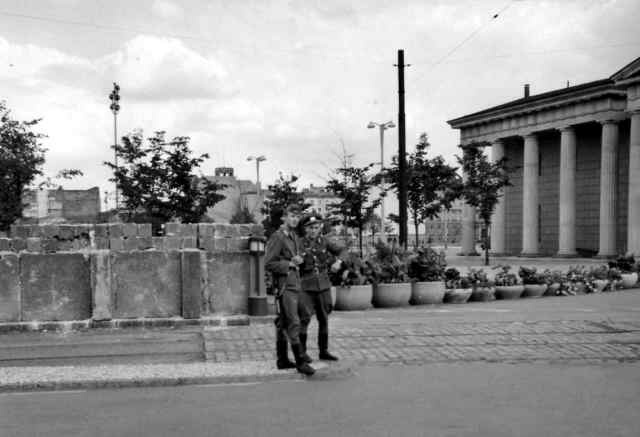
The pictures show here were taken in early August 1961. Ex RMP Malcolm Smith, who is the owner of the pictures, was seconded to 247 Pro Coy, Berlin for the emergency. They show the very early stages of the sector wall and the zonal fence being constructed by the Vopos and Grepos.
All photographs courtesy of and owned by ex RMP Malcolm Smith
The impetus for the creation of the Berlin Wall came from East German leader Walter Ulbricht, approved by Soviet leader Nikita Khrushchev, but with conditions imposed. Ulbricht’s proposal for a second air blockade was refused, and the construction of a barrier was permitted provided that it was composed at first of barbed wire.

Construction Begins
1961 East German construction workers building the Berlin Wall, 20 November 1961.On 15 June 1961, two months before the construction of the Berlin Wall started, Ulbricht stated in an international press conference, “Niemand hat die Absicht, eine Mauer zu errichten!” (No one has the intention to erect a wall). It was the first time the colloquial term Mauer (wall) had been used in this context.
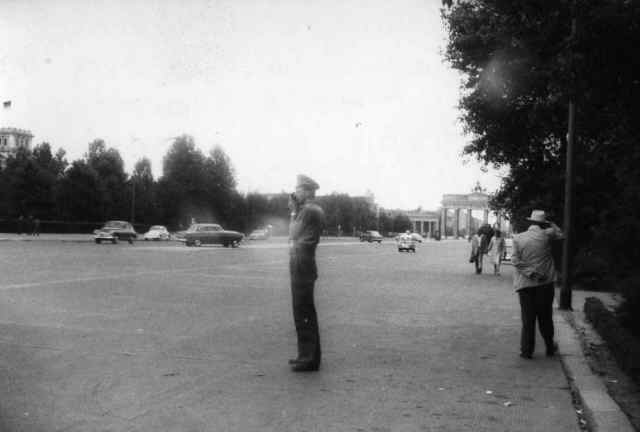
Straße des 17. Juni. In the background can be seen the Brandenburg Gate
On 12 August 1961, the leaders of East Germany attended a garden party at Döllnsee, formerly the hunting grounds of Hermann Göring. Construction of 156 km (97 miles) around the three western sectors began early on Sunday, 13 August 1961 in East Berlin, of which 43 km (27 mi.) actually divided West Berlin and East Berlin. The zonal boundary had been sealed that morning by East German troops. The barrier was built by East German troops and workers, not directly involving the Soviets.
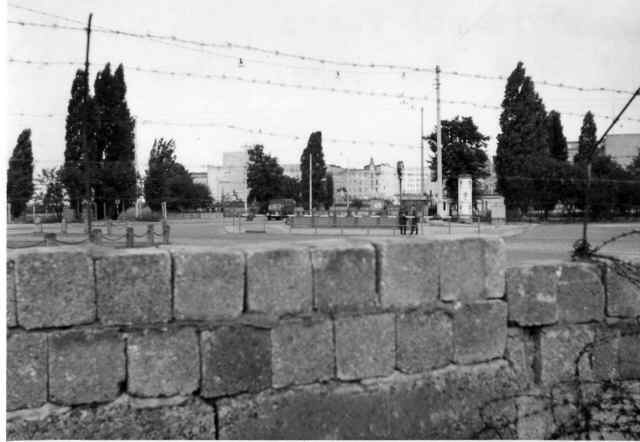
Potsdamer Platz – it has changed a little since this picture was taken.
It was built slightly inside East German territory to ensure that it did not encroach on West Berlin at any point. Some streets running alongside the barrier were torn up to make them impassable to most vehicles, and a barbed-wire fence was erected, which was later built up into the full-scale Wall. It physically divided the city and completely surrounded West Berlin. During the construction of the Wall, NVA and KdA soldiers stood in front of it with orders to shoot anyone who attempted to defect. Additionally, the whole length of the border between East and West Germany was closed with chain fences, walls, minefields, and other installations. To read further please click here.

The Brandenburg Gate looking to the south with the wall creeping up.
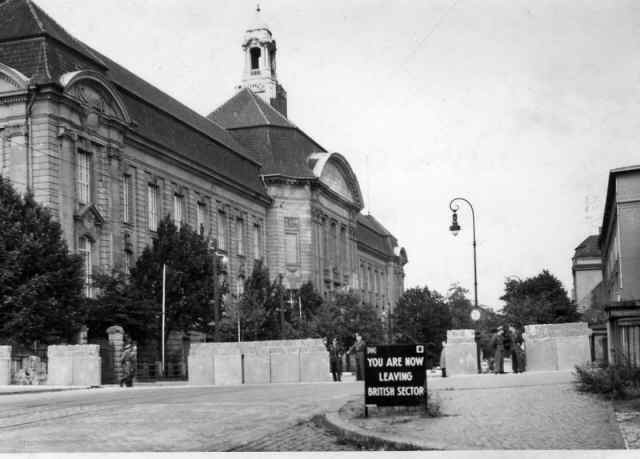
The border crossing at Invalidenstraße. “WARNING! You are now leaving West Berlin.”
Note – the British signs are always white on black.
In August 1961, I suddenly found myself Posted to 247 Pro Coy, Berlin. The powers that be decided to bring the western sector of Berlin up to full strength, this involved the RMP in BAOR sending one L/Cpl from each Provost Coy to Berlin. I was the one chosen from 4 Gds Bde based in Wuppertal.
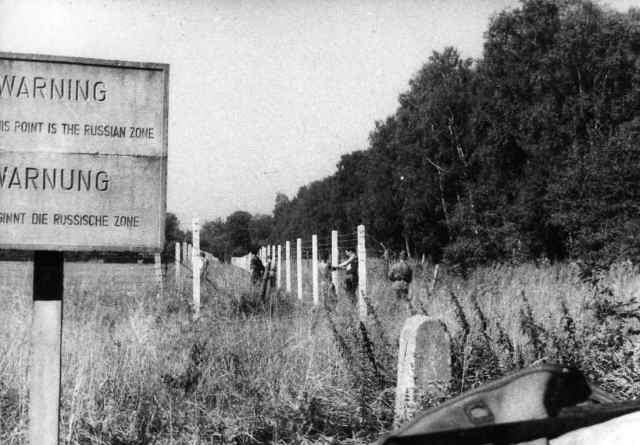
The zonal border between West Berlin and East Germany being reinforced by the Vopos (Volkspolizei – People’s Police) and the Grepos (Grenzpolizei – Border Police).
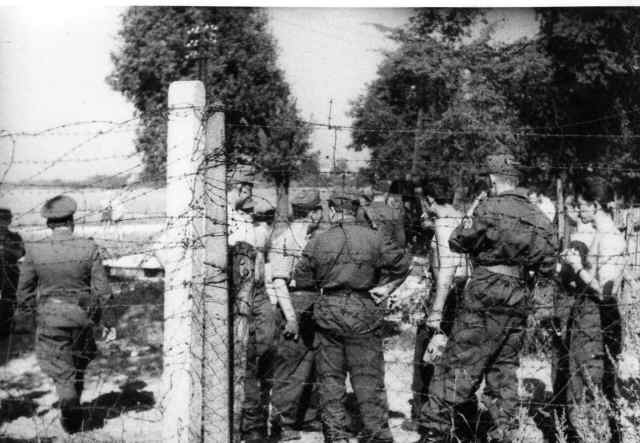
The main part of our duties consisted of doing Zonal border patrols and observation duties at the Sector border, such as at the Brandenburg Gate, but occasionally we had to do the ration run a couple of times a week to Helmstedt. The reason for this was that Helmstedt was an out section of 247 Berlin. Common sense makes you think that they would draw their rations from nearby Brunswick, but it gave us the excuse to exercise the right to use the Autobahn through the Russian zone. The procedure was as follows:- you left Berlin via the British check point with all of your documentation written in English, German and of course Russian. On arrival at the Russian check point you entered this wooden shed, about fifteen by twenty feet. The room was lined with tongue and groove panelling with very stern looking portraits of Marx, Lenin, Khruschchev, and Yuri Gagarin. On arrival at this office you went up to the small hatch, about twelve inches square with a small shelf in front of it. You rang the bell, the hatch would open, a hand would come out, take the papers from you and the hatch would close. And you waited, you could not proceed any further until your documents were stamped with all the correct stamps: they could keep you waiting for as long as they liked, which in my case was never more than ten or twenty minutes.
On one of these occasions I walked into the office and standing there was what the Americans call a full-bird Colonel. I whipped up my smartest salute and said good morning sir, he gave me the classic American wave towards the peak of his very decorated cap and said “Hi son.” He was dressed just like the cartoonist Giles drew them: medal ribbons galore and lanyards all over the place, and despite it being a dull day he was wearing sunglasses! At this point he went over to the hatch and started to bang his fist on the wall saying in a loud voice, “C’mon you Commie b——-s how long are you gonna keep me waiting?” He turned to me and said, “Son these b——s have kept me waiting for over half an hour, so prepare yourself for a long wait.” With that he gave the wall another thumping, with a few observations on the Russians’ parentage. I went to the hatch, rang the bell, the hatch opened, a hand came took my papers and closed again. The Colonel started to tell me what a load of !£$%*+_*%£:?# b——s these commie b_______s were, at this point the hatch opened, the American stepped forward saying, “About damned time.”, and was handed my papers!!!! Well I think you can guess the rest. I took my papers from him and left, I think there was a good chance he was there until the 9th of November 1989.
Courtesy of ex RMP Malcolm Smith
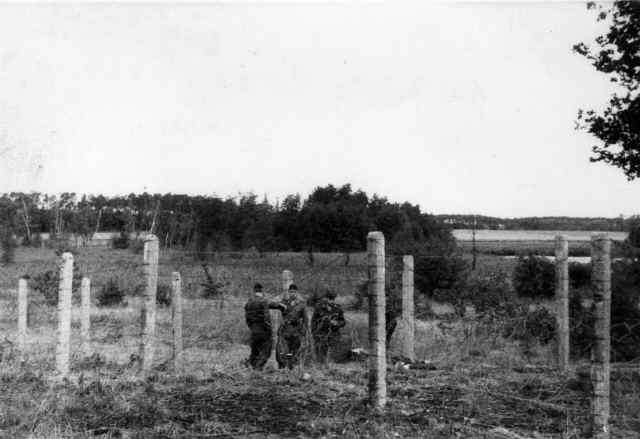

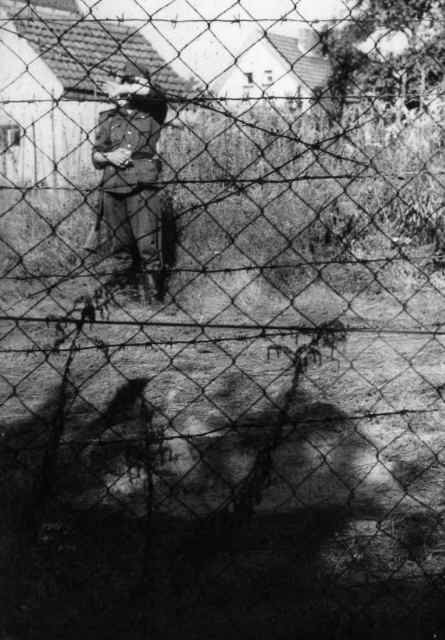
The Vopos were never one for having their picture taken.
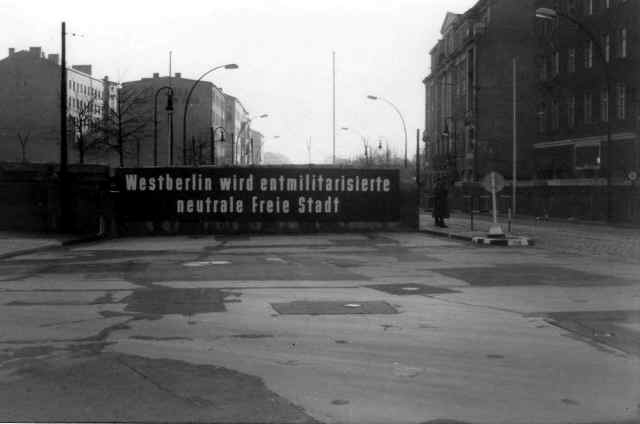
“West Berlin will be a non-military, neutral, free city.”
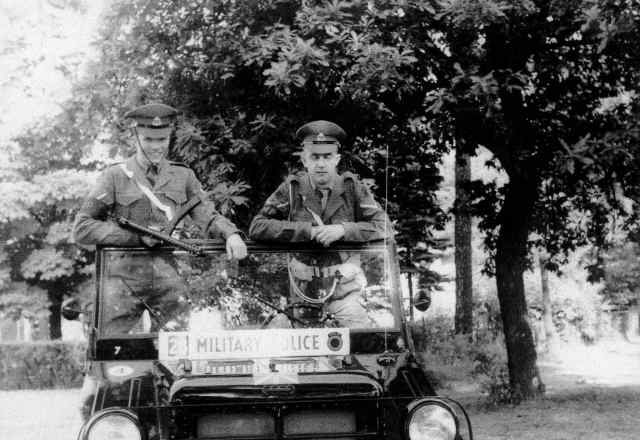
On the left can be seen Malcolm Smith, armed with a 9mm British made Sterling SMG whilst perched on an Auto Union DKV (later Audi) jeep.

An der Kappe – a street in the Spandau district of Berlin.
The picture shows our sign writer, John Brown with Johnny Whickham and Nobby Clarke together with a chap from the Daily Mirror. John Brown, the one on the left of the photo, went to art school in Birmingham, and of course was picked up by the RMP to be a signwriter, he painted all of the signs that said you are leaving the British sector. On leaving the Army he went to work for AP Films in Slough. You may remember, it was run by Gerry and Sylvia Anderson, they made the puppet films, such as Stingray and Thunderbirds, John made the puppets heads, He met his wife to be Wanda Webb, who was Lady Penelope’s puppeteer. Eventuality John moved on to what we call proper films such as Raise the Titanic and Jabberwocky, A Bridge too Far and most of the James Bond films. The lucky sod got to travel the world on location work. I think the last film he did before retirement was The Band Of Brothers. You might be interested to know that apart from location work in Holland and Austria it was all shot on the old Saving Private Ryan set in Hertfordshire, and that awful cold set in the Ardennes was in actual fact filmed in July! Good work by a company called Snow Business. I hope that little bit of useless information was interesting for you.
Courtesy of ex RMP Malcolm Smith
